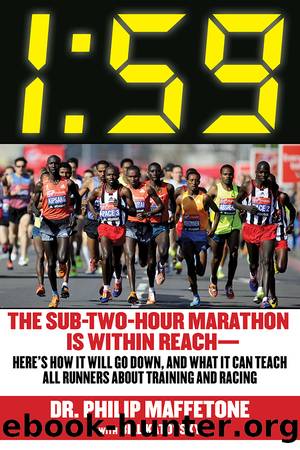1:59 by Philip Maffetone

Author:Philip Maffetone
Language: eng
Format: epub
Publisher: Skyhorse Publishing
Published: 2013-12-31T16:00:00+00:00
Mention strength training and many runners think of the following: tough hill repeats, interval workouts, or other anaerobic runs. But these workouts don’t produce the near-maximum muscle contractions that can increase strength like the correct weight program. And, as previously mentioned, anaerobic training can have a negative impact on building an effective aerobic system.
Many runners incorporate traditional weight-lifting programs in their regular training. This might involve going to the gym several times a week. Once there, they go from one machine to the next, using higher reps and lower weights. But this type of approach can be a disaster for a runner’s aerobic system and negatively impact one’s marathon performance. The reasons have to do with muscle bulk, which can add significant body weight, the production of excess muscle fatigue, which can interfere with one’s gait, and the release of stress hormones adversely affecting the aerobic system. These problems can significantly lead to reductions in running economy.
An example of the stress associated with traditional weight workouts is the usual requirement of a forty-eight-hour recovery time. This is due to excess muscle fatigue and associated stress hormone responses. But even performing an easy training run within this forty-eight-hour window can add to an already stressful condition, with the real potential of impairing the aerobic system and pushing one toward overtraining. Some studies show that adequate recovery from traditional weight training could take more than forty-eight hours. This type of routine, which includes a high number of reps, little rest between sets and lifting to fatigue, should be avoided.
For runners, strength goals should address the improvement of the whole body without impairing endurance, and be able to continue training the same or next day without pain, fatigue, or the risk of overtraining. This can be accomplished with the following:
- The use of relatively heavy weights
- Fewer repetitions
- Not lifting to fatigue
- Resting three minutes between sets
Strength is not always associated with muscle size. The brain plays a significant role in how much power a muscle generates, stimulating nerves that innervate individual muscle fibers to contract. The more fibers contracted, the more strength. Just having a large mass of muscle does not assure more fibers will be stimulated to generate extra power. A very lean athlete who can contract a lot of muscle fibers can be stronger than a bulky athlete who can’t contract as many fibers.
A muscle that is fatigued won’t contract as many fibers either. So it’s important to avoid workouts that are performed to more than mild fatigue. Avoid what is often encouraged in the gym—lifting to significant fatigue, sometimes to exhaustion.
This is not to say your muscles won’t get a bit tired when working out properly, just like after a long run. But it’s critical to avoid significant fatigue, which can be felt the next day as muscle soreness or even pain.
Despite the hype found in many magazine articles and on websites, not all weight-training routines result in better bone strength. In fact, the “no pain, no gain” approach
Download
This site does not store any files on its server. We only index and link to content provided by other sites. Please contact the content providers to delete copyright contents if any and email us, we'll remove relevant links or contents immediately.
Bodyweight Strength Training by Jay Cardiello(7185)
Tools of Titans by Timothy Ferriss(6947)
Born to Run: by Christopher McDougall(6260)
Inner Engineering: A Yogi's Guide to Joy by Sadhguru(5897)
Asking the Right Questions: A Guide to Critical Thinking by M. Neil Browne & Stuart M. Keeley(4574)
The Fat Loss Plan by Joe Wicks(4239)
Bodyweight Strength Training Anatomy by Bret Contreras(4060)
Yoga Anatomy by Kaminoff Leslie(3701)
Science and Development of Muscle Hypertrophy by Brad Schoenfeld(3578)
Dynamic Alignment Through Imagery by Eric Franklin(3489)
The Four-Pack Revolution by Chael Sonnen & Ryan Parsons(3484)
ACSM's Complete Guide to Fitness & Health by ACSM(3469)
Yoga Anatomy by Leslie Kaminoff & Amy Matthews(3396)
Bodyweight Strength Training: 12 Weeks to Build Muscle and Burn Fat by Jay Cardiello(3351)
The Ultimate Bodybuilding Cookbook by Kendall Lou Schmidt(3320)
Exercise Technique Manual for Resistance Training by National Strength & Conditioning Association(3292)
Nutrition for Sport, Exercise, and Health by Spano Marie & Kruskall Laura & Thomas D. Travis(3235)
Nutrition for Sport, Exercise, and Health by Marie Spano & Laura Kruskall & D. Travis Thomas(3232)
Yoga Therapy by Mark Stephens(3222)
